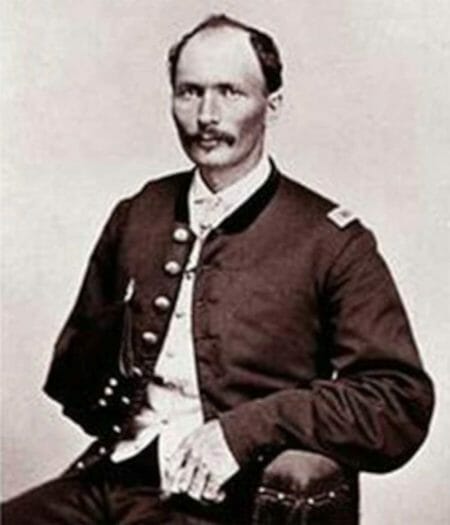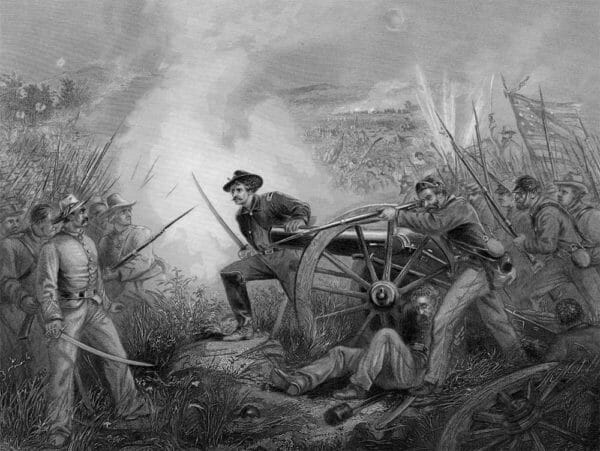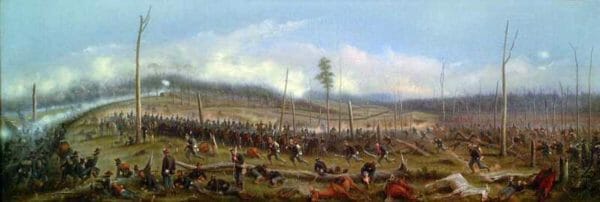By Katie Lange

USA – -(AmmoLand.com)- Army 1st Lt. Axel H. Reed joined the Union Army soon after the Civil War broke out. He fought valiantly through the entire conflict, even after he lost an arm during one of the two battles that earned him the Medal of Honor.

A descendant of the Mayflower Pilgrims, Reed was born on March 13, 1835, in Hartford, Maine; he was the youngest of seven children. Unfortunately, his mother died when he was 7. Within a few years, his three brothers and three sisters were scattered to live elsewhere. Reed stayed with his dad on the family farm because of his young age, despite continually asking to go off on his own.
Finally, at 19, Reed’s dad allowed him to leave. He gave him $5 and sent him on his way, according to Reed’s obituary in a 1917 issue of the Minneapolis Star Tribune.
Reed had done some research and determined that the best place to settle was out West, so he set off in April 1854 and ended his journey in Minnesota in November 1855. He found a job that lasted him through winter, but by the following spring, he’d received a contract to make bricks for use in building a new town called Glencoe, Minnesota. Over the next two years, he invested all his earnings into the town, which gave him permanent settler status.
By August 1861, the Civil War was raging, so Reed volunteered to fight. He joined the 2nd Minnesota Infantry Regiment and took part in several major campaigns.

Reed was a sergeant in July 1863 when he got into trouble at an encampment in Tennessee. According to the Minnesota Medal of Honor Memorial, Reed had “violated military discipline by indiscreetly criticizing the food.” As punishment, he was arrested and sent to the rear of his company with no weapons.
Reed remained under arrest as the regiment crossed the Cumberland Mountains and made its way to Chickamauga, Georgia, where they were confronted by Confederate soldiers on Sept. 19, 1863.
After begging his guards to let him fight, Reed finally left his place at the rear of the regiment, grabbed a rifle and headed for the battle lines. He spent the next two days helping pinned-down comrades fight the enemy. After the battle, Reed was officially released from his arrest in recognition of his bravery and devotion to the unit.
On Nov. 15, 1863, Reed led Company K of his regiment into battle at Missionary Ridge, Tennessee. As one of the first soldiers to cross into enemy territory, he captured enemy cannons and turned them on the fleeing Confederates before realizing they were out of ammunition.

According to the Minnesota Medal of Honor Memorial, Reed found two rebels trying to hitch horses onto a caisson to get away. He demanded they surrender and give him the ammunition in the caisson. When they didn’t, Reed fired at one of the rebels. As he tried to reload, he was hit by a mini-ball that shattered his right upper arm and knocked him to the ground, where he stayed until the fight was over.
Afterward, a fellow soldier helped Reed staunch the bleeding with a tourniquet. Reed then stumbled to the foot of the ridge to get medical help. He was taken to a hospital, where he spent the next three months. His right arm had to be amputated, but Reed refused to be discharged from service. He remained on active duty until the end of the war, when he mustered out as a first lieutenant on July 18, 1865.
Since the Medal of Honor was new during the Civil War, few were issued right away. It took 35 years for Reed to be notified that he’d earned it for his actions at Chickamauga and at Missionary Ridge. The medal was issued to him on April 2, 1898.

After the War
When the Civil War ended, Reed returned to Glencoe. He and an Army buddy bought a mercantile firm that they turned into a general merchandise and grain trading business. They ran it successfully for more than 30 years.
Reed married in 1869. He and his wife, Hannah, had two daughters and two sons over the next decade, although one of the girls died of scarlet fever, according to the Minnesota Medal of Honor Memorial.
Reed was heavily involved in the founding of Glencoe. According to the Star Tribune, he helped build the first railroad in 1873. The paper also said he organized the First National Bank of Glencoe in 1881 and was its president for a decade, and Reed published the Glencoe Enterprise newspaper from 1878-1889.
While Reed dabbled in politics, he was mostly interested in farming and agriculture. As one of the oldest members of the Minnesota State Horticultural Society, he “grew one of the first and largest apple orchards in the county and, at one time, was the largest producer of wheat,” his Star Tribune obituary said. Reed also belonged to several veterans’ organizations.
Reed died on Jan. 21, 1917, in the town he helped create. He was buried in Glencoe’s Mount Auburn Cemetery.
U.S. Department of Defense
The Department of Defense provides the military forces needed to deter war and ensure our nation’s security. The foundational strength of the Department of Defense is the men and women who volunteer to serve our country and protect our freedoms. Visit www.defense.gov/ to learn more.

